Foreign Direct Investment in the United States 2022
Foreign direct investment in the United States, known as FDIUS, reached $5 trillion cumulatively at the end of 2021 on a historical-cost basis. Every year, international firms make new investments, which benefit the American economy in numerous ways. International companies in the United States build new factories, fund U.S.-based research and development (R&D), and grow their well-established U.S. operations. They employ 7.9 million Americans in well-paying jobs.
International companies invested more than $400 billion in the United States in 2021, the third-highest level over the past decade, after lackluster FDIUS flows of $109 billion in 2020 (during the midst of the COVID-19 pandemic). This was the weakest year over the past decade. The two highest records of inward investments of $484 billion and $480 billion were recorded in 2015 and 2016, respectively.
Historically, the United Kingdom had been the largest cumulative overseas investor in the United States. But because of weak FDIUS flows in 2019 and divestments in 2020, Britain dropped in ranking to fourth place, behind Japan, Germany, and Canada, respectively. In contrast, these three countries continued to invest heavily in the United States. Together, Japan, Germany, Canada and the United Kingdom provide more than half of all foreign direct investment in the United States.
Over 40 percent of investments in the United States from international companies was in manufacturing through 2021 and nearly 40 percent of manufacturing FDIUS was in the chemicals sector. Finance and insurance, wholesale trade, and information rounded out the top four industries by FDIUS through 2021.
Globally, inward FDI surged nearly 80 percent to $1.65 trillion in 2021, according to the United Nations Conference on Trade and Development (UNCTAD) World Investment Report 2022 (WIR22). UNCTAD reported last year’s level exceeded pre-pandemic levels and was concentrated mostly in developed economies, like the United States. The United States was the world’s top destination for FDI in 2021; and cumulatively, the United States remains the world’s prime location for international investment. However, with heightened competition from other countries, the United States’ share of global investment shrank to 30 percent in 2021 from 34 percent in 2001. Most nations are eager to attract foreign investment, but many engage in protectionist activities, such as raising regulatory barriers for foreign investment and tightly monitoring cross-border mergers and acquisitions.
Whether the United States will remain the world’s most attractive investment location hinges on future macroeconomic developments, changing financial conditions, and other unforeseen worldwide developments. However, for the 10th consecutive year, A.T. Kearney’s 2022 FDI Confidence Index identified the United States as the world’s top market for foreign investment. It cited a business-friendly environment, market size, and technological infrastructure as three key factors.


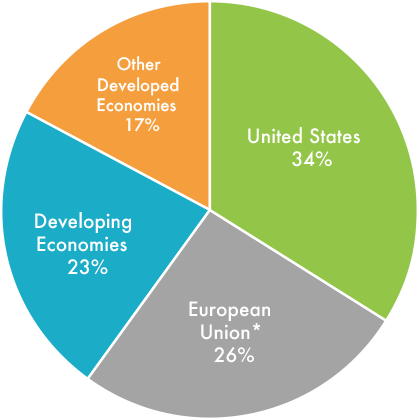
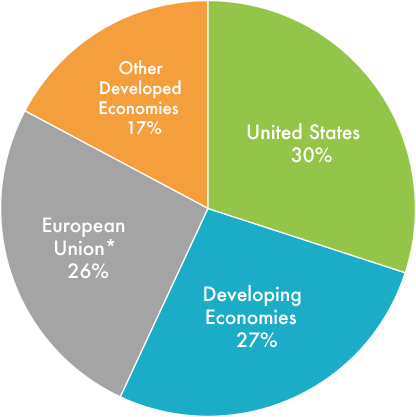
The United States faces stiff global competition for investment dollars. In 2021, it accounted for 30 percent of the world’s inward stock of foreign direct investment, down from 34 percent in 2001. But in 2011, the United States’ share of global FDI had fallen to just 17 percent. International investment in the United States has since rebounded to 30 percent. In recent years, many international investors have favored the United States as an investment location. The European Union’s share of worldwide FDI was at 26 percent both in 2001 and 2021, but had increased to 30 percent in 2011.
Although international companies are investing more in developing economies, with their share increasing by four percentage points since 2001, the stock of inward
investment in these markets remains lower than in the United States. By the end of 2021, developing economies recorded large gains and now claim 27 percent of worldwide investment stock. Large developing economies, including China, Hong Kong, and Singapore, are among the beneficiaries. Developing economies in the Middle East and Africa, such as Egypt, Morocco, and Saudi Arabia, also are attracting more foreign investment.
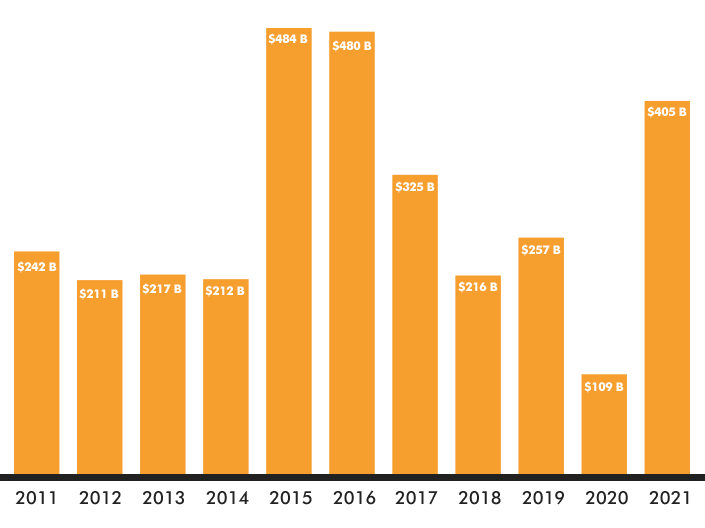
International companies invested over $400 billion in the United States last year, the third-highest level over the past decade, roughly quadrupling investment flows over 2020, which also had the lowest levels over the past 10 years.
Multinational companies headquartered abroad invested more than $480 billion in the United States in both 2015 and 2016, more than twice the amount invested in several years this past decade. Foreign direct investment in the United States consists of reinvestment of earnings, equity other than reinvestment of earnings, and debt instruments.
A few countries provided the majority of the $5 trillion in cumulative direct investment in the United States by the end of 2021. Japan was the single largest overseas investor, constituting nearly 15 percent of total cumulative foreign direct investment holdings. Germany overtook Canada last year as the second-largest investor in the United States with 13 percent in FDIUS stock. Until 2018, the United Kingdom was the largest investor in the United States, but it has recently dropped to fourth position. Ireland replaced France last year for fifth place.
The eight countries shown in the pie chart accounted for nearly three-fourths of total FDI stock in the United States in 2021. More than 100 other countries represented the remainder.
This publication shows country data by ultimate beneficial owner, which reflects the actual ownership of a foreign firm in the United States.
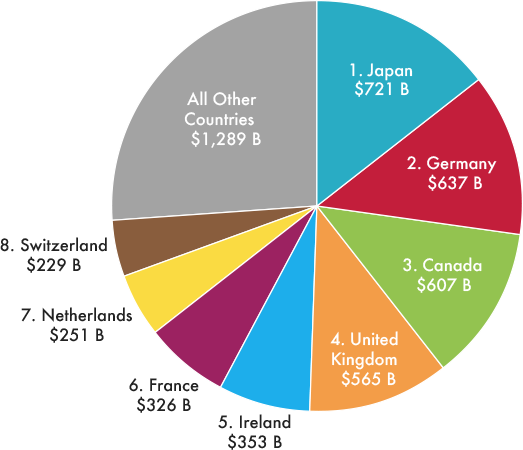
Germany’s investment stock in the United States increased more than 80 percent over the past five years, moving the country up to second place from fourth. During the same time period, South Korea increased its total investment in the United States by more than 70 percent, rising from the 16th-ranked country in 2016 to 12th last year.
Japan was the fourth-fastest growing country by FDIUS between 2016 and 2021, moving from second to first place. Luxembourg increased its investment stock in the United States by more than 60 percent over the past five years. Between 2015 and 2020, Ireland, the Netherlands, Brazil, Switzerland and Canada each increased their investment stake in the United States by at least 40 percent.

Cumulatively, Europe was the largest regional investor in the United States. It made up 56 percent of all foreign investment through 2021. These figures include the 27 European Union (EU) countries and other European nations with investment stakes in the United States, such as the United Kingdom, Switzerland, and Norway. The Asia and Pacific region was second, accounting for 21 percent of FDI stock in the United States through 2021, while Canada held 12 percent, ahead of several regions. In 2021, the Caribbean and Atlantic Islands held three percent of FDI stock in the United States while South and Central America and the Middle East each held two percent. Bermuda was the largest investor from these regions through 2021, while FDI stock from Mexico reached $48 billion. Investment from Africa remained tiny at $6 billion at the end of 2021. With 84 percent, South Africa accounted for the lion’s share of the African continent’s direct investment in the United States last year.
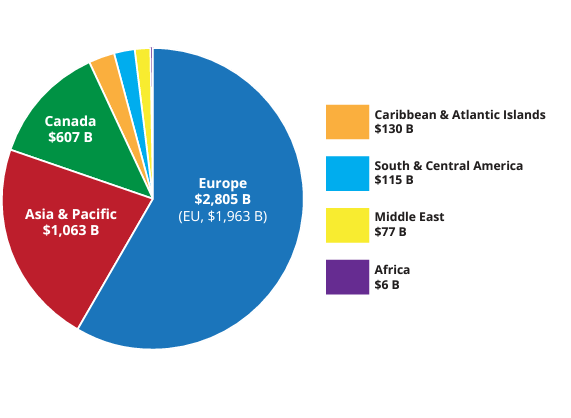
Note: Canada is treated as a region in this graph and analysis. Data are shown on a historical-cost basis, or cost at time of investment. Source: Bureau of Economic Analysis
The five major emerging economies of Brazil, Russia, India, China, and South Africa are known collectively as BRICS. Despite the size of their economies, combined BRICS’ investment registered just 2.5 percent of all foreign investment stock in the United States at the end of 2021; as a group, its investment increased 21 percent from 2016. China ranked as the largest BRICS investor with $54 billion through 2021. Its investment dropped by one percent over the past five years. Russia’s cumulative direct investment of some $4 billion in the United States shrank by 10 percent during the same period. At $14 billion through 2021, India was the third-largest BRICS investor in the United States and the fastest growing, increasing 70 percent over the past five years. The second-largest increase in FDIUS from the BRICS was from Brazil, adding nearly 50 percent of investment stock into the United States between 2016 and 2021. South Africa’s cumulative investment registered $5 billion by the end of last year.
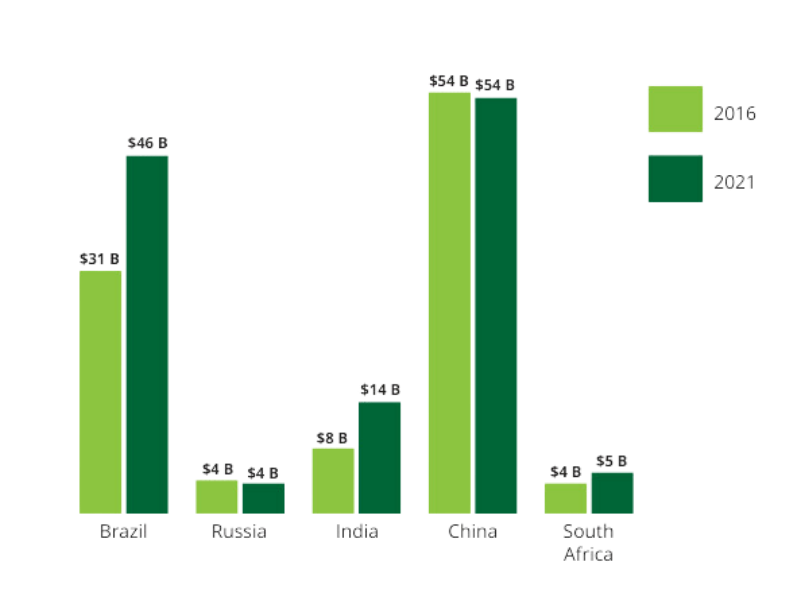
A few countries provided the majority of the $5 trillion in cumulative direct investment in the United States by the end of 2021. Japan was the single largest overseas investor, constituting nearly 15 percent of total cumulative foreign direct investment holdings. Germany overtook Canada last year as the second-largest investor in the United States with 13 percent in FDIUS stock. Until 2018, the United Kingdom was the largest investor in the United States, but it has recently dropped to fourth position. Ireland replaced France last year for fifth place.
The eight countries shown in the pie chart accounted for nearly three-fourths of total FDI stock in the United States in 2021. More than 100 other countries represented the remainder.
This publication shows country data by ultimate beneficial owner, which reflects the actual ownership of a foreign firm in the United States.

Of the largest industries, cumulative foreign investment in America’s retail trade sector grew the fastest, at 120 percent to $154 billion in 2021 from $70 billion in 2016. Cumulative FDIUS in the real estate and rental and leasing sector also more than doubled during the same time. FDI stock in information rose 64 percent over the past five years, pushing it higher than cumulative FDIUS in several other sectors. Meanwhile, investment in manufacturing, by far the largest sector, and finance and insurance both grew by 43 percent. Total inward foreign direct investment rose 32 percent in wholesale trade, the third-largest sector.
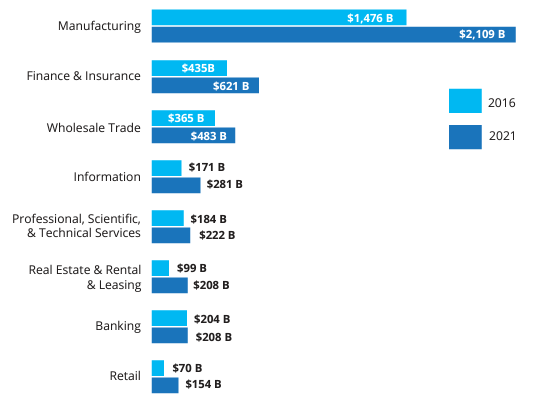
International firms invested heavily in the U.S. manufacturing sector. Chemicals garnered $821 billion in total FDI stock by the end of 2021, representing 39 percent of all foreign investment in domestic manufacturing. International companies spend billions annually in the U.S. chemicals industry because it boasts a highly educated workforce, world-class research centers, strong intellectual property protections, and a robust regulatory system. Nearly two-thirds of all FDI stock in U.S. chemicals was in pharmaceuticals and medicines. Multinational companies invested almost $220 billion in the U.S. computers and electronic products sector by year-end 2021. Foreign investment in transportation equipment, mostly in autos and auto parts manufacturing, totaled $180 billion through the end of last year. Medical equipment and food ranked fourth and fifth, respectively, each at more than $115 billion last year. International investment in the electrical equipment, appliances, and components sector totaled more than $110 billion through 2021.
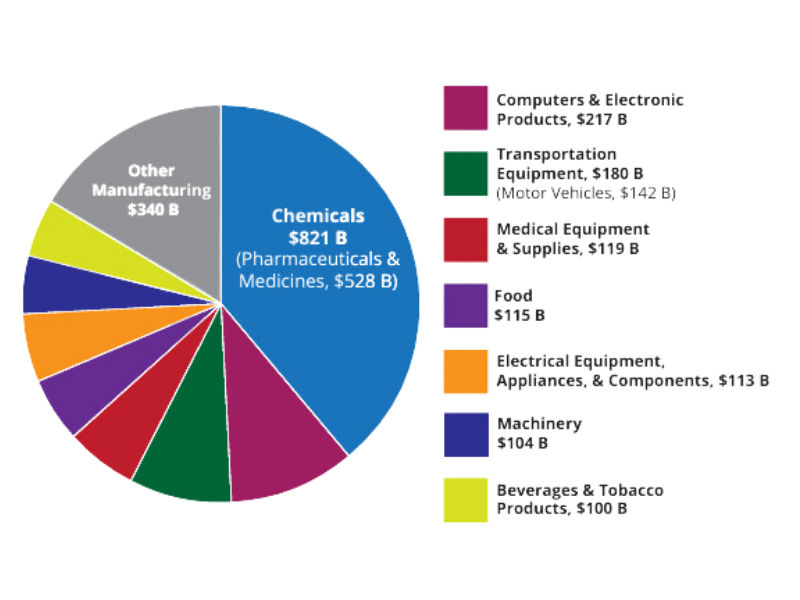
Total foreign direct investment in America’s medical equipment and supplies manufacturing sector more than tripled between 2016 and 2021 to $119 billion, the fastest rate of growth among manufacturing sectors. International firms more than doubled their investment in two key technology manufacturing sectors: electrical equipment, appliances, and components as well as computers and electronic products. The fourth-fastest growing manufacturing sector by FDIUS was food, which jumped by nearly 65 percent over the past five years, followed by beverages and tobacco products. Beverages make up the vast majority of this segment. International investment in the U.S. chemicals industry increased by 28 percent over the past five years.
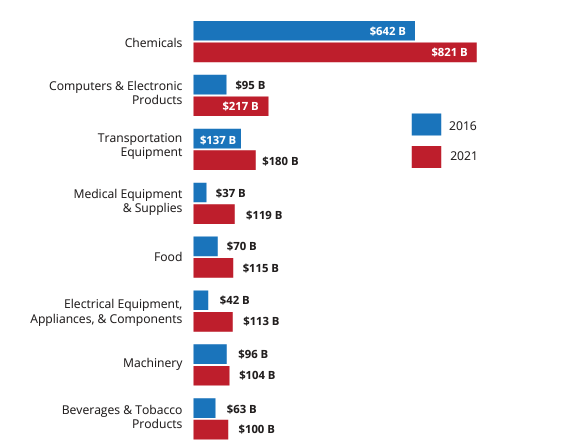
Data are shown on a historical-cost basis, or cost at time of investment.
*Only manufacturing sectors with at least $100 billion in 2021 FDIUS are shown.
Source: Bureau of Economic Analysis
International investment in the U.S. semiconductors and other electronic components sector has seen explosive growth over the past five years at 194 percent. Semiconductors play an integral role in all aspects of modern life because they operate as the computing brains not only for computers, but also for household appliances, medical devices, automobiles, and many other industries. Foreign-headquartered semiconductor companies’ recent investments in the United States has translated into nearly 58,000 well-compensated American jobs. International investments in this crucial U.S. industry may be bolstered with the recent enactment of the CHIPS and Science Act. The new law includes grants, research investments, and an investment tax credit aimed at strengthening domestic chip manufacturing. TSMC, headquartered in Taiwan, is constructing a semiconductor fabrication plant in Arizona. Samsung (headquartered in South Korea) also intends to invest $17 billion in a new semiconductor manufacturing facility in Texas to augment its existing chip production base in the state.